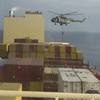The 2001 maritime crime statistics are now in, and, as expected, acts of piracy doubled. As predicted in a previous article, we have now seen the very publicized piracy and kidnapping off the coast of Somalia. The very public unconfirmed report of a U.S. $200,000 ransom has set the precedence for future piracy and kidnapping payoffs. While everyone is extremely happy that all 18 crewmembers returned home, it poses even more questions for the maritime industry.
One of the first questions should be "What does our current insurance policy cover?"
In the aftermath of September 11, many insurance companies have revised their policies concerning acts of terrorism. Do specific policies need to be addressed to cover actual crew kidnappings even if kidnapped during piracy? In many instances the insurance company will consider the ship itself to be the liability and pay for its return (which could include the crew). But, what if the ship is to be kept by the pirates and the crew is the only item on the bargaining table? This creates new circumstances, which require new solutions.
One solution might be to provide kidnapping and ransom insurance (KRI) to every ship captain within the organization. This is somewhat costly but not too severe if a policy can be written for specific voyages. The problem of the crew still remains though. For example, a captain's KRI insurance would provide cash to negotiate the entire crews release but the kidnappers may feel otherwise. Kidnappers might take the attitude that if negotiations can be conducted for the captain's release the rest of the crew is merely a liability. Another solution might be to provide additional security personnel to each vessel traveling in hostile waters. This also poses a problem if the right professionals are not used. What good is an unarmed security professional that doesn't understand pirate tactics and how to prevent attack?
Neither of these solutions helps the victimized company recover the loss of future cargo due to an attack. The loss of the use of the ship while it is being held in negotiation is costing money every day. The loss of time for the customer who expects their shipment to arrive on the other end is costing the shipping company either immediately or in litigation later. The liability suits from victimized crewmembers will cost the company directly and indirectly through an increase in insurance rates.
So what can be done to limit these attacks? The major point to take into consideration is the nature of the attack. The attack off the Somalia coast is the type of attack, which will become more prevalent in the future. This type of attack is conducted by small guerilla elements with limited capabilities to sell the ship or it's cargo. These types of pirates generally want the cash onboard and any goods that can easily be transferred. Of course they can also hold a crew for ransom when conditions are appropriate. These pirates generally have little or no weapons training and limited ship-boarding capabilities.
I realize that most people are afraid of anyone pointing a gun at them and rightfully so. However, from years of experience training many militaries around the world I can attest to the fact that many simply do not receive the training necessary to effectively engage targets. Given the fact that any training pirates receive will more than likely have been from a stint in the military. I think it is safe to say their skills are limited. Therefore, if crews can receive non-lethal training, which can exploit the weaknesses of the pirates, then many of these acts can be thwarted.
Highly trained specialists can act as advisors to work with the crew and navigate hostile waters effectively. These types of pirates are looking for an easy target. If preferably before, or even during an attack they perceive their prey to be too difficult they will look for other opportunities against different vessels. I have personally seen this theory proved on the ground and in the water numerous times.
These pirates are much like the "bully" in high school, they attack the weak. That is not said to offend any crew ever attacked by pirates. I am really saying that the brave crewmembers sailing today are willing to protect themselves and their ship at all costs they just need the skills and knowledge to be effective.
The more difficult pirates are those involved in organized crime syndicates. These pirates are actually more dangerous because they are relying on the ship and its cargo for payment. The crew itself is often times a liability. They are also more sophisticated and have high-tech equipment to aid in their attacks. They usually have an intelligence network that enables them to key on certain vessels carrying certain cargo. Effectively dealing with organized crime pirates requires a layered approach involving harbor security, information gathering and sharing and of course effective counter-measures at sea. Next month's column will focus on harbor security and address some of these information gathering and sharing ideas.
Sponsored Content
Chris-Marine’s solutions help to prolong engine lifetime

March 2024
 Read the Magazine
Read the Magazine

 Read the Magazine
Read the Magazine
This issue sponsored by:

America’s Watershed Initiative: Sustaining a Critical Waterway
Subscribe for
Maritime Reporter E-News
Maritime Reporter E-News is the maritime industry's largest circulation and most authoritative ENews Service, delivered to your Email five times per week










